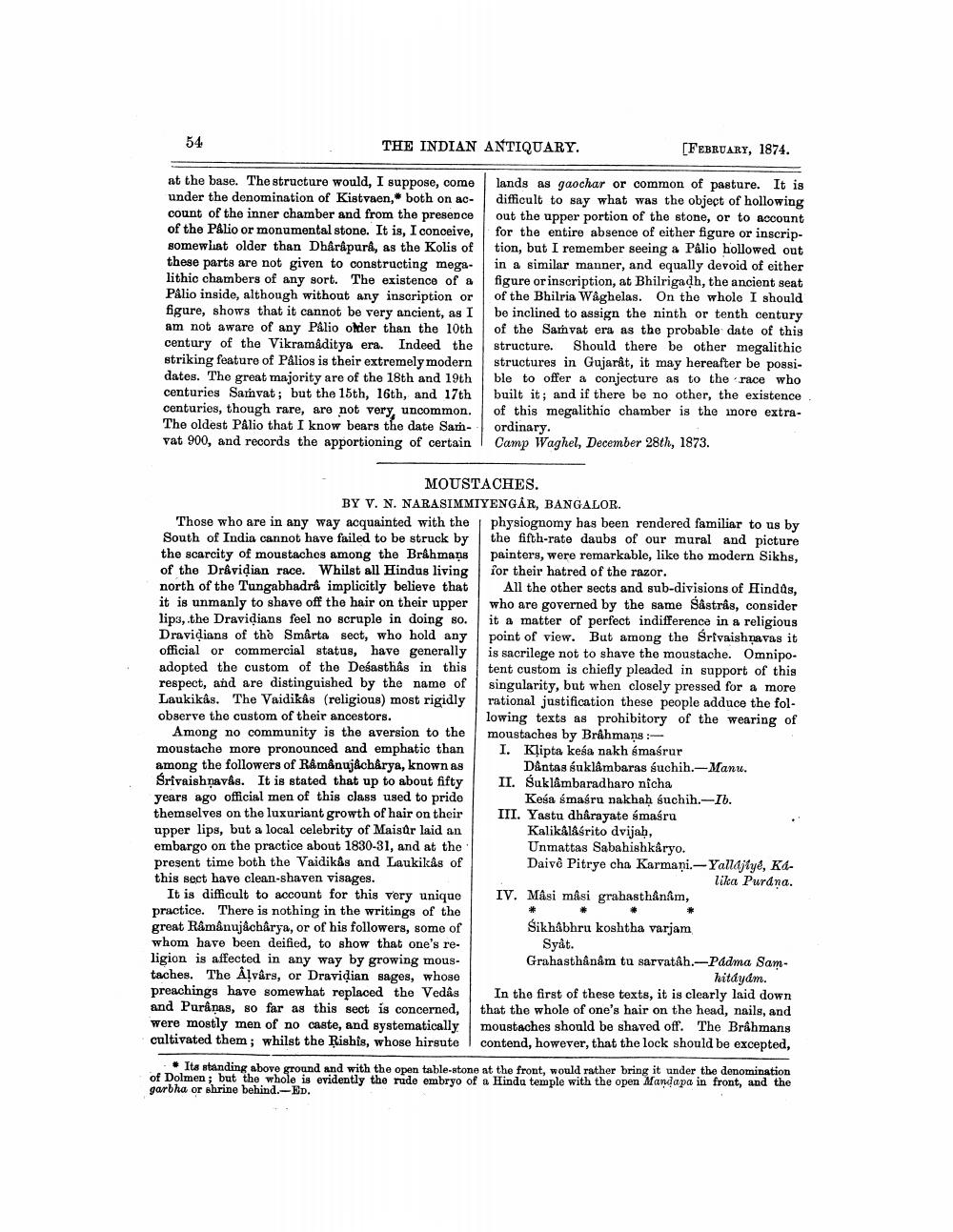________________
54
THE INDIAN ANTIQUARY.
[FEBRUARY, 1874.
at the base. The structure would, I suppose, come under the denomination of Kistvaen, both on account of the inner chamber and from the presence of the Palio or monumental stone. It is, I conceive, somewhat older than Dharapura, as the Kolis of these parts are not given to constructing megalithic chambers of any sort. The existence of a Palio inside, although without any inscription or figure, shows that it cannot be very ancient, as I am not aware of any PÅlio older than the 10th century of the Vikramaditya era. Indeed the striking feature of Pålios is their extremely modern dates. The great majority are of the 18th and 19th centuries Samvat; but the 15th, 16th, and 17th centuries, though rare, are not very, uncommon. The oldest PAlio that I know bears the date Sam- vat 900, and records the apportioning of certain
lands as gaochar or common of pasture. It is difficult to say what was the object of hollowing out the upper portion of the stone, or to account for the entire absence of either figure or inscription, but I remember seeing a Palio hollowed out in a similar manner, and equally devoid of either figure orinscription, at Bhilrigadh, the ancient seat of the Bhilria Wåghelas. On the whole I should be inclined to assign the ninth or tenth century of the Samvat era as the probable date of this structure. Should there be other megalithic structures in Gujarât, it may hereafter be possible to offer a conjecture as to the race who built it; and if there be no other, the existence of this megalithic chamber is the more extraordinary. Camp Waghel, December 28th, 1873.
MOUSTACHES.
BY V. N. NARASIMMIYENGÅR, BANGALOR. Those who are in any way acquainted with the physiognomy has been rendered familiar to us by South of India cannot have failed to be struck by | the fifth-rate daubs of our mural and picture the scarcity of moustaches among the Brâhmans painters, were remarkable, like tho modern Sikhs, of the Dravidian race. Whilst all Hindus living for their hatred of the razor. north of the Tungabhadrâ implicitly believe that All the other sects and sub-divisions of Hindus, it is unmanly to shave off the hair on their upper who are governed by the same Såstrås, consider lips, the Dravidians feel no scruple in doing so. it a matter of perfect indifference in a religious Dravidians of tho Smärta sect, who hold any point of view. But among the Srivaishnavas it official or commercial status, have generally is sacrilege not to shave the moustache. Omnipo. adopted the custom of the Desasthas in this tent custom is chiefly pleaded in support of this respect, and are distinguished by the name of singularity, but when closely pressed for a more Laukikâs. The Vaidikâs (religious) most rigidly rational justification these people adduce the folobserve the custom of their ancestors.
lowing texts as prohibitory of the wearing of Among no community is the aversion to the moustaches by Brahmans: moustache more pronounced and emphatio than I. Kļipta keśa nakh smaśrur among the followers of Ramanujach&rya, known as
Dantas suklámbaras suchih.-Manu. Srivaishnavas. It is stated that up to about fifty II. Suklámbaradharo nicha years ago official men of this class used to pride
Kesa smaśru nakhaḥ suchih.-Ib. themselves on the luxuriant growth of hair on their III. Yastu dhấrayate smaśru upper lips, but a local celebrity of Maisar laid an
Kalikklåsrito dvijah, embargo on the practice about 1830-31, and at the
Unmattas Sabahishkaryo. present time both the Vaidikâs and Laukikas of
Daivė Pitrye cha Karmaņi.-Yallajiye, Kathis sect have clean-shaven visages.
lika Purana. It is difficult to account for this very unique IV. Masi måsi grabasthanam, practice. There is nothing in the writings of the great Ramanujacharya, or of his followers, some of Sikhabhru koshtha varjam whom have been deified, to show that one's re
Syåt. ligion is affected in any way by growing mous
Grahasthânâm tu sarvatah.--Padma Samtaches. The Aļvârs, or Dravidian sages, whose
hitayam. preachings have somewhat replaced the Vedas In the first of these texts, it is clearly laid down and Puranas, so far as this sect is concerned, that the whole of one's hair on the head, nails, and were mostly men of no caste, and systematically moustaches should be shaved off. The Brâhmang cultivated them; whilst the Rishis, whose hirsute contend, however, that the lock should be excepted,
Its standing above ground and with the open table-stone at the front, would rather bring it under the denomination of Dolmen ; but the whole is evidently the rude embryo of a Hindu temple with the open Mandapa in front, and the garbha or shrine behind.-Ed.




